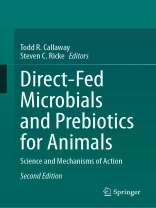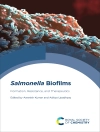In this exciting update, readers will learn how feeding direct-fed microbials (including eubiotics, postbiotics, prebiotics, and synbiotics) is becoming increasingly widespread during food animal production. Animal production must improve efficiency of growth, and the use of direct-fed microbial and prebiotic additives to domestic animals has become widely accepted and utilized. The benefits of probiotic-type approaches in cattle, pigs, fish, and poultry, include improved general animal health, reduced foodborne pathogen populations, increased growth rate and feed efficiency, improved milk and egg production, and have been reported world-wide. Successes from probiotic approaches in multiple species have ensured their adoption; however, several fundamental questions remain. Early establishment and retention of an ecological balance in the gastrointestinal tract is an important first step for an external biological additive to be effective in young animals, suggesting that some of the benefits of direct-fed microbials may be due to an early establishment of a “normal” native gut microbial population. Research has indicated that the establishment of a normal population can enhance gut epithelial integrity, preventing inflammation and improving animal health. Thus, it is important that we understand the key processes that occur during the establishment of the gut microbial population that can impact gastrointestinal fermentation and provide protection against pathogens of the animals and of human consumers.
Knowing how these processes work and how they impact animal energy and protein expenditures can guide further improvements of available and future commercial products. Exciting research opportunities are discussed in this book, examining different characteristics of DFMs that are fed to animals to meet different production demands in different production scenarios (e.g., beef versus dairy versus swine versusfin fish). The advent of molecular and next-generation sequencing offers methods of developing tailored DFMs, and of early detection of successful DFM establishment in the gut. These techniques will further deepen our insight into understanding the microbial population of the gut and how these populations impact animal health, food safety, and sustainability of animal-derived protein production.
İçerik tablosu
First edition:
I. Overview of Direct-Fed Microbials and Prebiotics and Their Interactions with the Host.- 1. The Commensal Microbiota.- 2. Prebiotics of Plant and Microbial Origin.- 3. Microbial Species Characteristics and Selection.- 4. Genomics of Probiotic-Host Interactions.- 5. The Effects of Pre- and Probiotics on the Host Immune Response.- II. Current and Future Status of Practical Applications and Challenges.- 6. Current Status of Practical Applications: Pets.- 7. Current Perspectives on Probiotics in Poultry Preharvest Food Safety.- 8. Current Status of Practical Applications: Probiotics in Dairy Cattle.- 9. Current Future Status of Practical Applications: Beef Cattle.- 10. Future Challenges of Administration of Direct-Fed Microbial Supplementation to Swine.- 11. Characteristics and Modification of the Intestinal Tract Microbiota of Channel Catfish Ictalurus punctatus.- 12. The Use of Direct-Fed Microbials as a Pre-Harvest Food Safety Intervention in Cattle.
Second edition with proposed changes in attachment.
Yazar hakkında
Dr. Todd R. Callaway received his B.S. Agriculture degree in Animal Health and Animal and Dairy Sciences, as well as his M.S. in Animal and Dairy Sciences from the University of Georgia. He received his Ph.D. in Microbiology from Cornell University, with minors in Biochemistry and Animal Science. Dr. Callaway is a Research Microbiologist for the Agricultural Research Service of the U.S. Department of Agriculture, and has served as a Science Fellow for the Foreign Agriculture Service and the U.S. State Department. He has adjunct faculty appointments in the Department of Agriculture at Angelo State University, the Animal and Dairy Sciences Department at Mississippi State University, and the Department of Animal Science at Texas A&M University. Dr. Callaway has a research program focused on manipulating the microbial ecology of the animal gastrointestinal tract to reduce populations of foodborne pathogenic bacteria in food animals before they enter the food chain.
Dr. Steven C. Ricke received his B.S. degree in Animal Science and M.S. degree in Ruminant Nutrition from the University of Illinois and his Ph.D. degree from the University of Wisconsin with a co-major in Animal Science and Bacteriology. He is currently holder of the Donald “Buddy” Wray Endowed Chair in Food Safety and Director of the Center for Food Safety at the University of Arkansas. He is also a faculty member of the Department of Food Science, the Department of Poultry Science and the Cellular and Molecular Graduate program. Dr. Ricke’s research program is primarily focused on virulence and pathogenic characteristics of foodborne salmonellae.












